Qantas Corporate Strategy: CSR, Ethics, and Diversity
VerifiedAdded on 2021/02/20
|10
|3193
|103
Report
AI Summary
This report provides a comprehensive analysis of Qantas' corporate strategy, examining its approach to Corporate Social Responsibility (CSR), sustainability, and ethical practices. It delves into Qantas' use of Carroll's Pyramid of CSR, the Triple Bottom Line framework, and ethical theories like Utilitarianism and Deontology. The report also explores stakeholder analysis, highlighting key stakeholders and the application of stakeholder theory. Furthermore, it addresses diversity within the workplace, including the application of the self-categorization theory. The analysis covers Qantas' initiatives and strategies over the past 3-5 years, offering insights into the airline's approach to achieving its organizational goals and maintaining a competitive advantage.
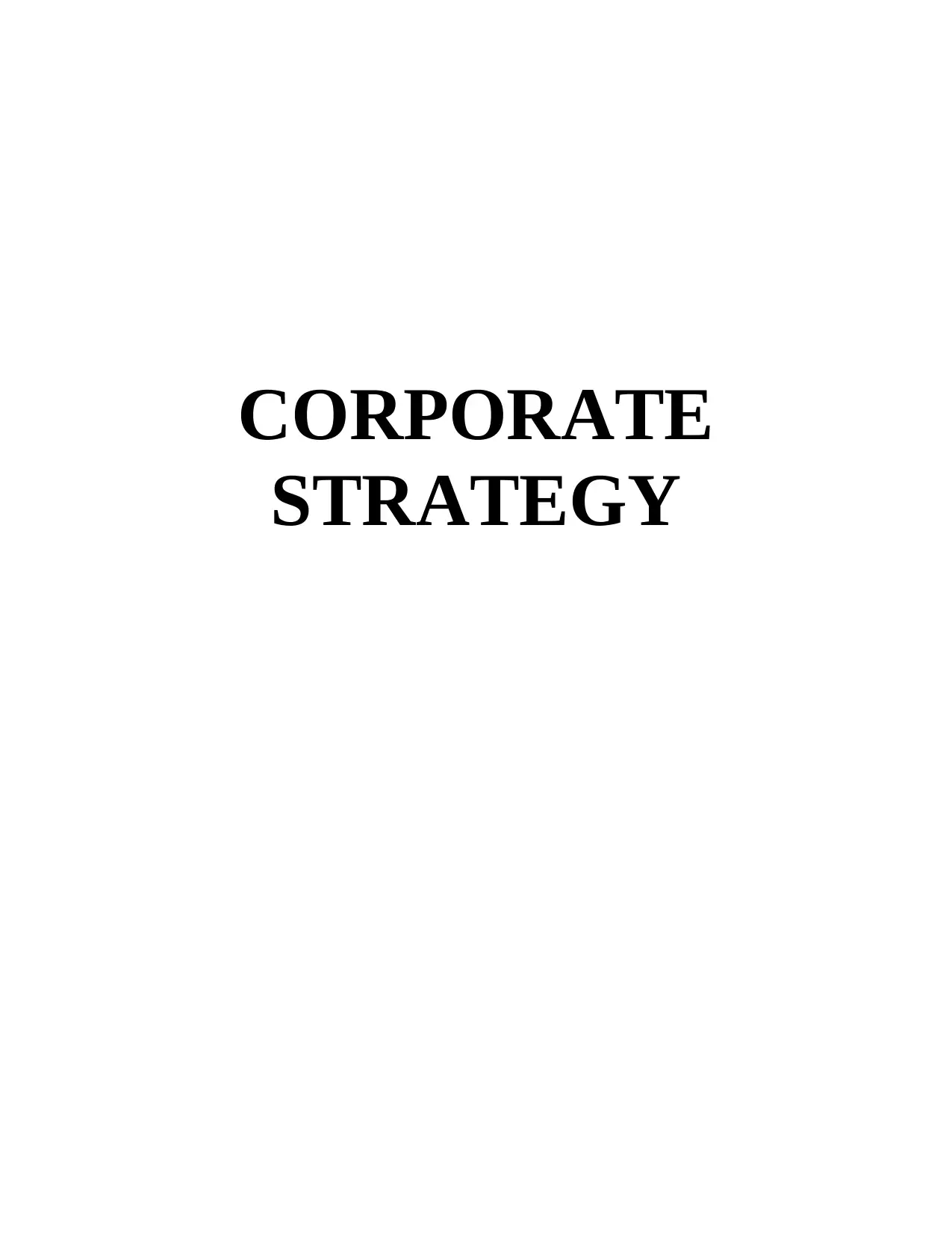
CORPORATE
STRATEGY
STRATEGY
Paraphrase This Document
Need a fresh take? Get an instant paraphrase of this document with our AI Paraphraser
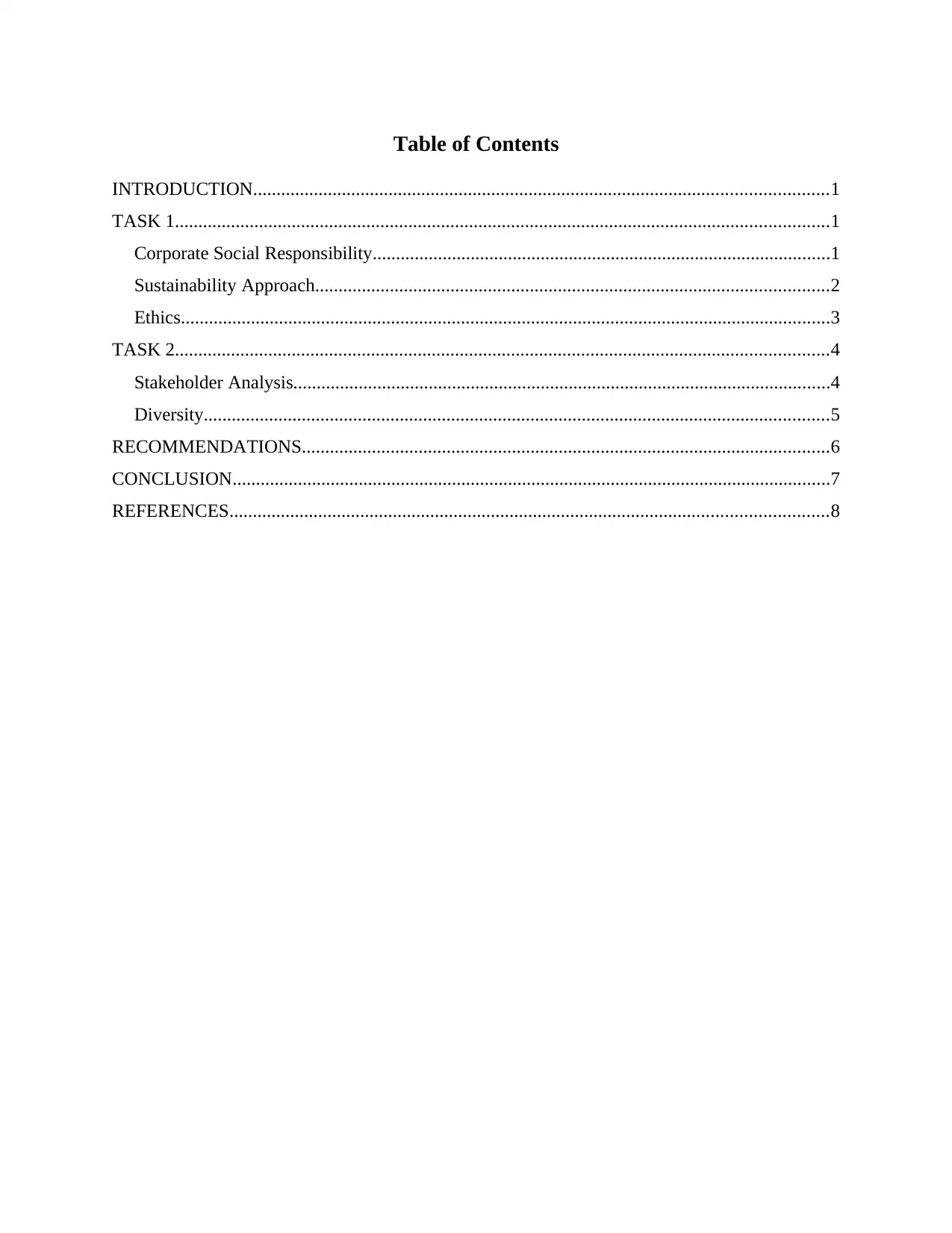
Table of Contents
INTRODUCTION...........................................................................................................................1
TASK 1............................................................................................................................................1
Corporate Social Responsibility..................................................................................................1
Sustainability Approach..............................................................................................................2
Ethics...........................................................................................................................................3
TASK 2............................................................................................................................................4
Stakeholder Analysis...................................................................................................................4
Diversity......................................................................................................................................5
RECOMMENDATIONS.................................................................................................................6
CONCLUSION................................................................................................................................7
REFERENCES................................................................................................................................8
INTRODUCTION...........................................................................................................................1
TASK 1............................................................................................................................................1
Corporate Social Responsibility..................................................................................................1
Sustainability Approach..............................................................................................................2
Ethics...........................................................................................................................................3
TASK 2............................................................................................................................................4
Stakeholder Analysis...................................................................................................................4
Diversity......................................................................................................................................5
RECOMMENDATIONS.................................................................................................................6
CONCLUSION................................................................................................................................7
REFERENCES................................................................................................................................8
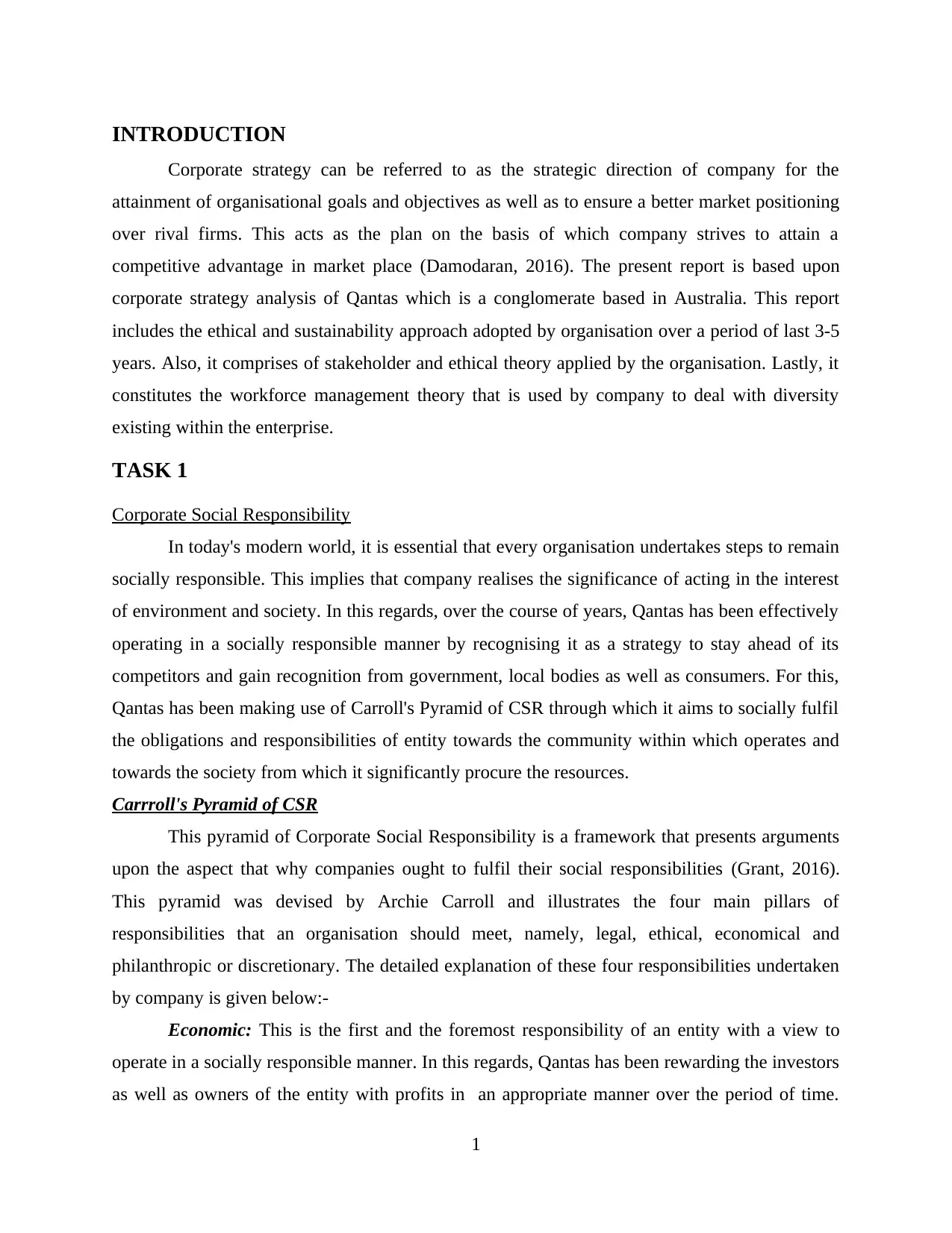
INTRODUCTION
Corporate strategy can be referred to as the strategic direction of company for the
attainment of organisational goals and objectives as well as to ensure a better market positioning
over rival firms. This acts as the plan on the basis of which company strives to attain a
competitive advantage in market place (Damodaran, 2016). The present report is based upon
corporate strategy analysis of Qantas which is a conglomerate based in Australia. This report
includes the ethical and sustainability approach adopted by organisation over a period of last 3-5
years. Also, it comprises of stakeholder and ethical theory applied by the organisation. Lastly, it
constitutes the workforce management theory that is used by company to deal with diversity
existing within the enterprise.
TASK 1
Corporate Social Responsibility
In today's modern world, it is essential that every organisation undertakes steps to remain
socially responsible. This implies that company realises the significance of acting in the interest
of environment and society. In this regards, over the course of years, Qantas has been effectively
operating in a socially responsible manner by recognising it as a strategy to stay ahead of its
competitors and gain recognition from government, local bodies as well as consumers. For this,
Qantas has been making use of Carroll's Pyramid of CSR through which it aims to socially fulfil
the obligations and responsibilities of entity towards the community within which operates and
towards the society from which it significantly procure the resources.
Carrroll's Pyramid of CSR
This pyramid of Corporate Social Responsibility is a framework that presents arguments
upon the aspect that why companies ought to fulfil their social responsibilities (Grant, 2016).
This pyramid was devised by Archie Carroll and illustrates the four main pillars of
responsibilities that an organisation should meet, namely, legal, ethical, economical and
philanthropic or discretionary. The detailed explanation of these four responsibilities undertaken
by company is given below:-
Economic: This is the first and the foremost responsibility of an entity with a view to
operate in a socially responsible manner. In this regards, Qantas has been rewarding the investors
as well as owners of the entity with profits in an appropriate manner over the period of time.
1
Corporate strategy can be referred to as the strategic direction of company for the
attainment of organisational goals and objectives as well as to ensure a better market positioning
over rival firms. This acts as the plan on the basis of which company strives to attain a
competitive advantage in market place (Damodaran, 2016). The present report is based upon
corporate strategy analysis of Qantas which is a conglomerate based in Australia. This report
includes the ethical and sustainability approach adopted by organisation over a period of last 3-5
years. Also, it comprises of stakeholder and ethical theory applied by the organisation. Lastly, it
constitutes the workforce management theory that is used by company to deal with diversity
existing within the enterprise.
TASK 1
Corporate Social Responsibility
In today's modern world, it is essential that every organisation undertakes steps to remain
socially responsible. This implies that company realises the significance of acting in the interest
of environment and society. In this regards, over the course of years, Qantas has been effectively
operating in a socially responsible manner by recognising it as a strategy to stay ahead of its
competitors and gain recognition from government, local bodies as well as consumers. For this,
Qantas has been making use of Carroll's Pyramid of CSR through which it aims to socially fulfil
the obligations and responsibilities of entity towards the community within which operates and
towards the society from which it significantly procure the resources.
Carrroll's Pyramid of CSR
This pyramid of Corporate Social Responsibility is a framework that presents arguments
upon the aspect that why companies ought to fulfil their social responsibilities (Grant, 2016).
This pyramid was devised by Archie Carroll and illustrates the four main pillars of
responsibilities that an organisation should meet, namely, legal, ethical, economical and
philanthropic or discretionary. The detailed explanation of these four responsibilities undertaken
by company is given below:-
Economic: This is the first and the foremost responsibility of an entity with a view to
operate in a socially responsible manner. In this regards, Qantas has been rewarding the investors
as well as owners of the entity with profits in an appropriate manner over the period of time.
1
⊘ This is a preview!⊘
Do you want full access?
Subscribe today to unlock all pages.

Trusted by 1+ million students worldwide
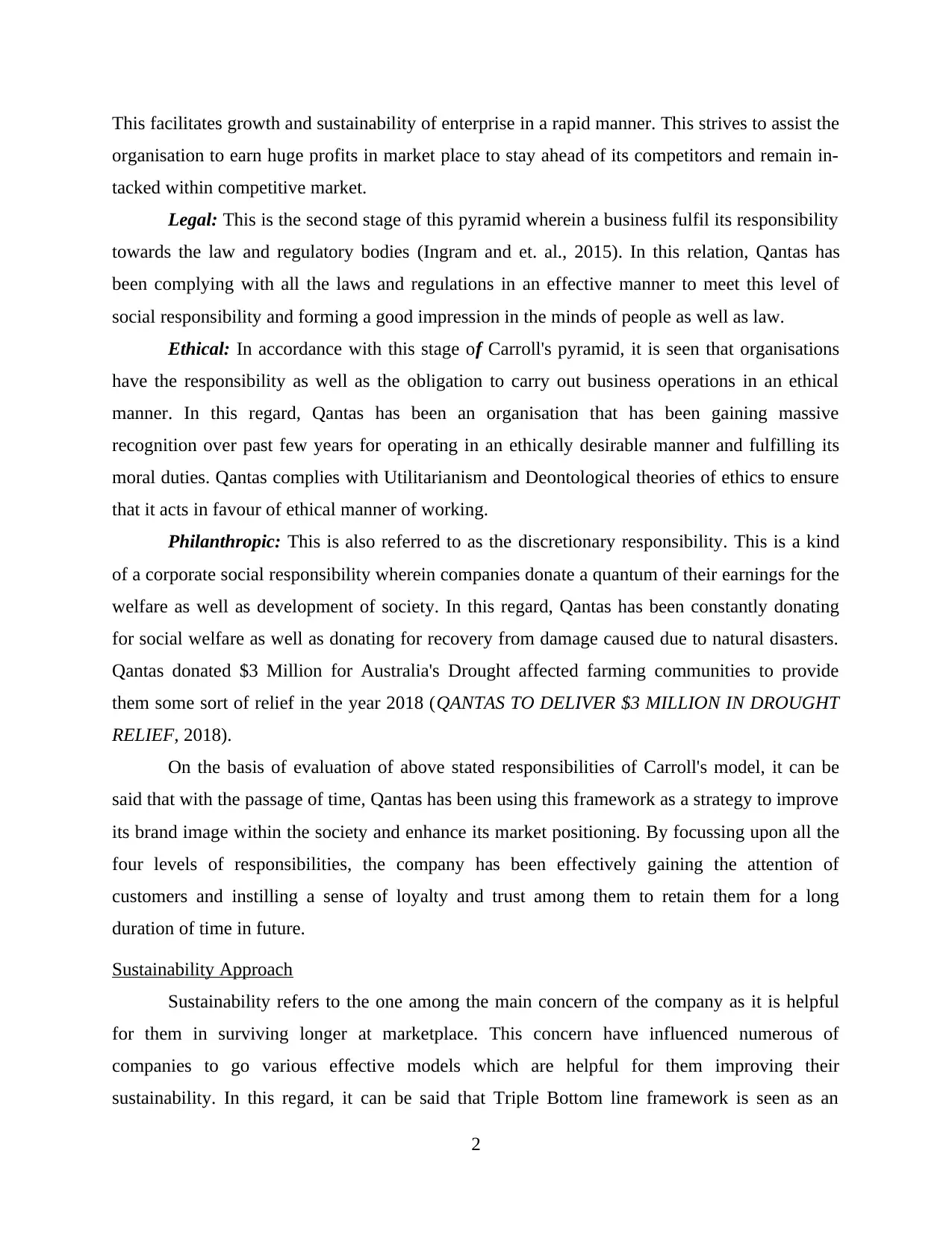
This facilitates growth and sustainability of enterprise in a rapid manner. This strives to assist the
organisation to earn huge profits in market place to stay ahead of its competitors and remain in-
tacked within competitive market.
Legal: This is the second stage of this pyramid wherein a business fulfil its responsibility
towards the law and regulatory bodies (Ingram and et. al., 2015). In this relation, Qantas has
been complying with all the laws and regulations in an effective manner to meet this level of
social responsibility and forming a good impression in the minds of people as well as law.
Ethical: In accordance with this stage of Carroll's pyramid, it is seen that organisations
have the responsibility as well as the obligation to carry out business operations in an ethical
manner. In this regard, Qantas has been an organisation that has been gaining massive
recognition over past few years for operating in an ethically desirable manner and fulfilling its
moral duties. Qantas complies with Utilitarianism and Deontological theories of ethics to ensure
that it acts in favour of ethical manner of working.
Philanthropic: This is also referred to as the discretionary responsibility. This is a kind
of a corporate social responsibility wherein companies donate a quantum of their earnings for the
welfare as well as development of society. In this regard, Qantas has been constantly donating
for social welfare as well as donating for recovery from damage caused due to natural disasters.
Qantas donated $3 Million for Australia's Drought affected farming communities to provide
them some sort of relief in the year 2018 (QANTAS TO DELIVER $3 MILLION IN DROUGHT
RELIEF, 2018).
On the basis of evaluation of above stated responsibilities of Carroll's model, it can be
said that with the passage of time, Qantas has been using this framework as a strategy to improve
its brand image within the society and enhance its market positioning. By focussing upon all the
four levels of responsibilities, the company has been effectively gaining the attention of
customers and instilling a sense of loyalty and trust among them to retain them for a long
duration of time in future.
Sustainability Approach
Sustainability refers to the one among the main concern of the company as it is helpful
for them in surviving longer at marketplace. This concern have influenced numerous of
companies to go various effective models which are helpful for them improving their
sustainability. In this regard, it can be said that Triple Bottom line framework is seen as an
2
organisation to earn huge profits in market place to stay ahead of its competitors and remain in-
tacked within competitive market.
Legal: This is the second stage of this pyramid wherein a business fulfil its responsibility
towards the law and regulatory bodies (Ingram and et. al., 2015). In this relation, Qantas has
been complying with all the laws and regulations in an effective manner to meet this level of
social responsibility and forming a good impression in the minds of people as well as law.
Ethical: In accordance with this stage of Carroll's pyramid, it is seen that organisations
have the responsibility as well as the obligation to carry out business operations in an ethical
manner. In this regard, Qantas has been an organisation that has been gaining massive
recognition over past few years for operating in an ethically desirable manner and fulfilling its
moral duties. Qantas complies with Utilitarianism and Deontological theories of ethics to ensure
that it acts in favour of ethical manner of working.
Philanthropic: This is also referred to as the discretionary responsibility. This is a kind
of a corporate social responsibility wherein companies donate a quantum of their earnings for the
welfare as well as development of society. In this regard, Qantas has been constantly donating
for social welfare as well as donating for recovery from damage caused due to natural disasters.
Qantas donated $3 Million for Australia's Drought affected farming communities to provide
them some sort of relief in the year 2018 (QANTAS TO DELIVER $3 MILLION IN DROUGHT
RELIEF, 2018).
On the basis of evaluation of above stated responsibilities of Carroll's model, it can be
said that with the passage of time, Qantas has been using this framework as a strategy to improve
its brand image within the society and enhance its market positioning. By focussing upon all the
four levels of responsibilities, the company has been effectively gaining the attention of
customers and instilling a sense of loyalty and trust among them to retain them for a long
duration of time in future.
Sustainability Approach
Sustainability refers to the one among the main concern of the company as it is helpful
for them in surviving longer at marketplace. This concern have influenced numerous of
companies to go various effective models which are helpful for them improving their
sustainability. In this regard, it can be said that Triple Bottom line framework is seen as an
2
Paraphrase This Document
Need a fresh take? Get an instant paraphrase of this document with our AI Paraphraser
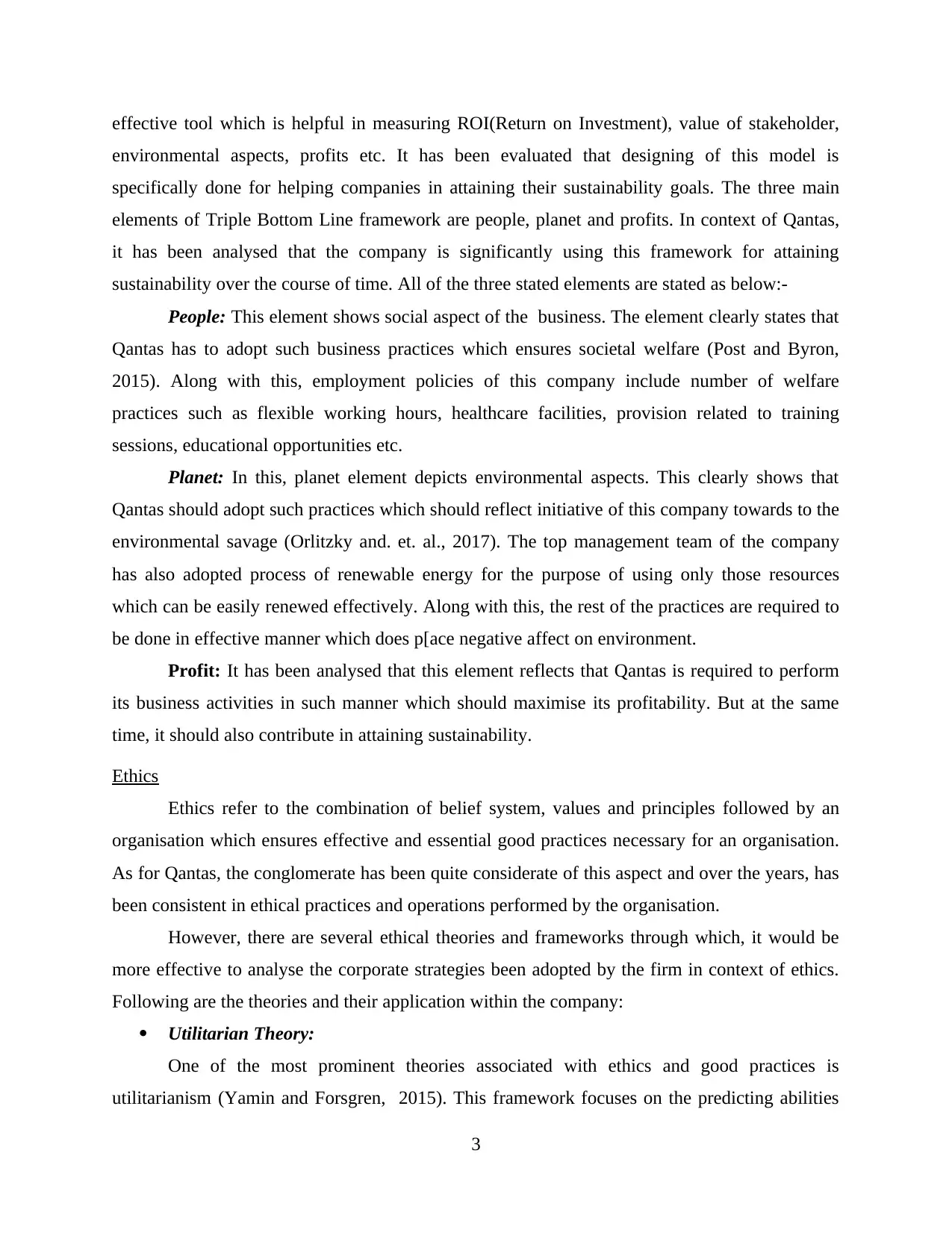
effective tool which is helpful in measuring ROI(Return on Investment), value of stakeholder,
environmental aspects, profits etc. It has been evaluated that designing of this model is
specifically done for helping companies in attaining their sustainability goals. The three main
elements of Triple Bottom Line framework are people, planet and profits. In context of Qantas,
it has been analysed that the company is significantly using this framework for attaining
sustainability over the course of time. All of the three stated elements are stated as below:-
People: This element shows social aspect of the business. The element clearly states that
Qantas has to adopt such business practices which ensures societal welfare (Post and Byron,
2015). Along with this, employment policies of this company include number of welfare
practices such as flexible working hours, healthcare facilities, provision related to training
sessions, educational opportunities etc.
Planet: In this, planet element depicts environmental aspects. This clearly shows that
Qantas should adopt such practices which should reflect initiative of this company towards to the
environmental savage (Orlitzky and. et. al., 2017). The top management team of the company
has also adopted process of renewable energy for the purpose of using only those resources
which can be easily renewed effectively. Along with this, the rest of the practices are required to
be done in effective manner which does p[ace negative affect on environment.
Profit: It has been analysed that this element reflects that Qantas is required to perform
its business activities in such manner which should maximise its profitability. But at the same
time, it should also contribute in attaining sustainability.
Ethics
Ethics refer to the combination of belief system, values and principles followed by an
organisation which ensures effective and essential good practices necessary for an organisation.
As for Qantas, the conglomerate has been quite considerate of this aspect and over the years, has
been consistent in ethical practices and operations performed by the organisation.
However, there are several ethical theories and frameworks through which, it would be
more effective to analyse the corporate strategies been adopted by the firm in context of ethics.
Following are the theories and their application within the company:
Utilitarian Theory:
One of the most prominent theories associated with ethics and good practices is
utilitarianism (Yamin and Forsgren, 2015). This framework focuses on the predicting abilities
3
environmental aspects, profits etc. It has been evaluated that designing of this model is
specifically done for helping companies in attaining their sustainability goals. The three main
elements of Triple Bottom Line framework are people, planet and profits. In context of Qantas,
it has been analysed that the company is significantly using this framework for attaining
sustainability over the course of time. All of the three stated elements are stated as below:-
People: This element shows social aspect of the business. The element clearly states that
Qantas has to adopt such business practices which ensures societal welfare (Post and Byron,
2015). Along with this, employment policies of this company include number of welfare
practices such as flexible working hours, healthcare facilities, provision related to training
sessions, educational opportunities etc.
Planet: In this, planet element depicts environmental aspects. This clearly shows that
Qantas should adopt such practices which should reflect initiative of this company towards to the
environmental savage (Orlitzky and. et. al., 2017). The top management team of the company
has also adopted process of renewable energy for the purpose of using only those resources
which can be easily renewed effectively. Along with this, the rest of the practices are required to
be done in effective manner which does p[ace negative affect on environment.
Profit: It has been analysed that this element reflects that Qantas is required to perform
its business activities in such manner which should maximise its profitability. But at the same
time, it should also contribute in attaining sustainability.
Ethics
Ethics refer to the combination of belief system, values and principles followed by an
organisation which ensures effective and essential good practices necessary for an organisation.
As for Qantas, the conglomerate has been quite considerate of this aspect and over the years, has
been consistent in ethical practices and operations performed by the organisation.
However, there are several ethical theories and frameworks through which, it would be
more effective to analyse the corporate strategies been adopted by the firm in context of ethics.
Following are the theories and their application within the company:
Utilitarian Theory:
One of the most prominent theories associated with ethics and good practices is
utilitarianism (Yamin and Forsgren, 2015). This framework focuses on the predicting abilities
3
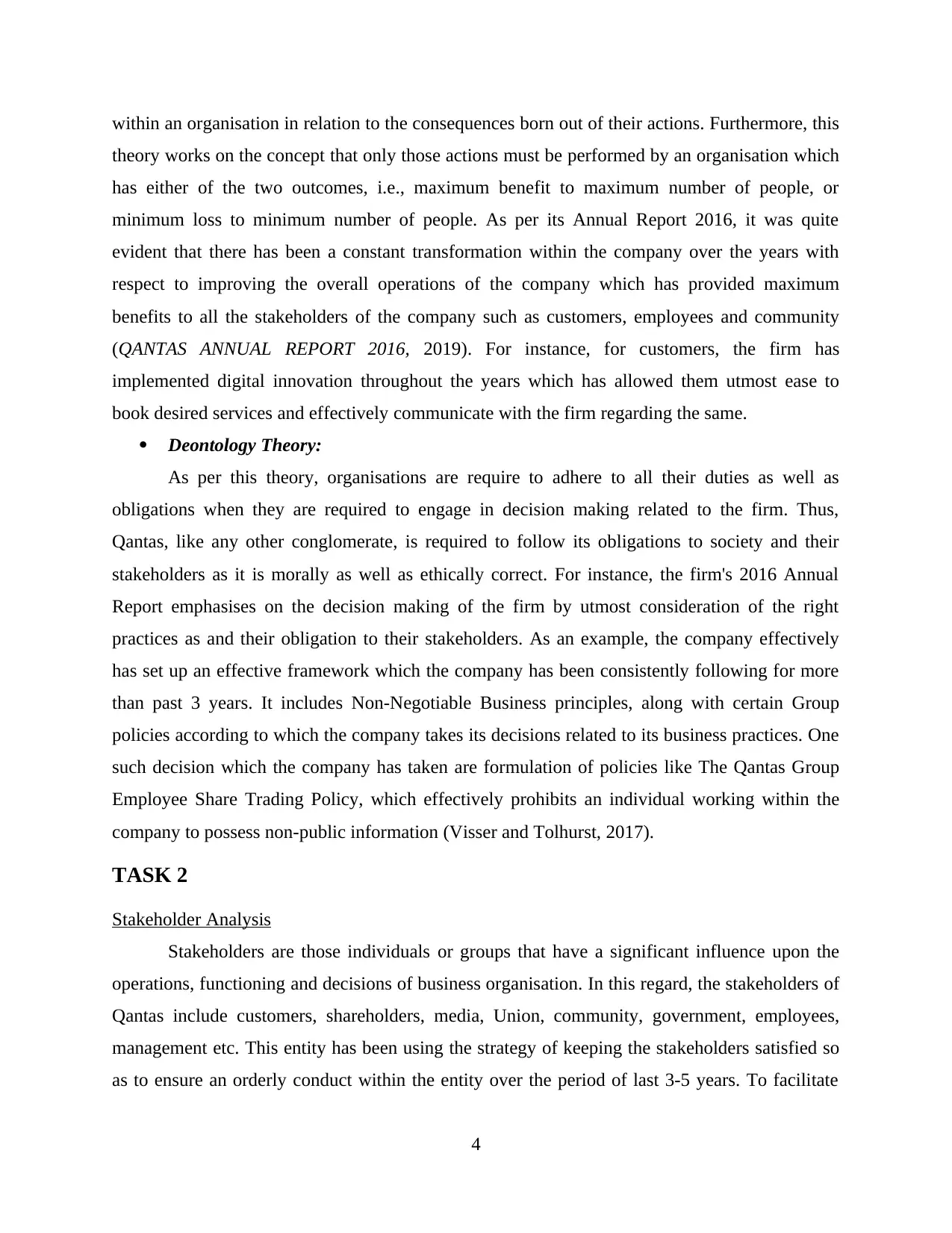
within an organisation in relation to the consequences born out of their actions. Furthermore, this
theory works on the concept that only those actions must be performed by an organisation which
has either of the two outcomes, i.e., maximum benefit to maximum number of people, or
minimum loss to minimum number of people. As per its Annual Report 2016, it was quite
evident that there has been a constant transformation within the company over the years with
respect to improving the overall operations of the company which has provided maximum
benefits to all the stakeholders of the company such as customers, employees and community
(QANTAS ANNUAL REPORT 2016, 2019). For instance, for customers, the firm has
implemented digital innovation throughout the years which has allowed them utmost ease to
book desired services and effectively communicate with the firm regarding the same.
Deontology Theory:
As per this theory, organisations are require to adhere to all their duties as well as
obligations when they are required to engage in decision making related to the firm. Thus,
Qantas, like any other conglomerate, is required to follow its obligations to society and their
stakeholders as it is morally as well as ethically correct. For instance, the firm's 2016 Annual
Report emphasises on the decision making of the firm by utmost consideration of the right
practices as and their obligation to their stakeholders. As an example, the company effectively
has set up an effective framework which the company has been consistently following for more
than past 3 years. It includes Non-Negotiable Business principles, along with certain Group
policies according to which the company takes its decisions related to its business practices. One
such decision which the company has taken are formulation of policies like The Qantas Group
Employee Share Trading Policy, which effectively prohibits an individual working within the
company to possess non-public information (Visser and Tolhurst, 2017).
TASK 2
Stakeholder Analysis
Stakeholders are those individuals or groups that have a significant influence upon the
operations, functioning and decisions of business organisation. In this regard, the stakeholders of
Qantas include customers, shareholders, media, Union, community, government, employees,
management etc. This entity has been using the strategy of keeping the stakeholders satisfied so
as to ensure an orderly conduct within the entity over the period of last 3-5 years. To facilitate
4
theory works on the concept that only those actions must be performed by an organisation which
has either of the two outcomes, i.e., maximum benefit to maximum number of people, or
minimum loss to minimum number of people. As per its Annual Report 2016, it was quite
evident that there has been a constant transformation within the company over the years with
respect to improving the overall operations of the company which has provided maximum
benefits to all the stakeholders of the company such as customers, employees and community
(QANTAS ANNUAL REPORT 2016, 2019). For instance, for customers, the firm has
implemented digital innovation throughout the years which has allowed them utmost ease to
book desired services and effectively communicate with the firm regarding the same.
Deontology Theory:
As per this theory, organisations are require to adhere to all their duties as well as
obligations when they are required to engage in decision making related to the firm. Thus,
Qantas, like any other conglomerate, is required to follow its obligations to society and their
stakeholders as it is morally as well as ethically correct. For instance, the firm's 2016 Annual
Report emphasises on the decision making of the firm by utmost consideration of the right
practices as and their obligation to their stakeholders. As an example, the company effectively
has set up an effective framework which the company has been consistently following for more
than past 3 years. It includes Non-Negotiable Business principles, along with certain Group
policies according to which the company takes its decisions related to its business practices. One
such decision which the company has taken are formulation of policies like The Qantas Group
Employee Share Trading Policy, which effectively prohibits an individual working within the
company to possess non-public information (Visser and Tolhurst, 2017).
TASK 2
Stakeholder Analysis
Stakeholders are those individuals or groups that have a significant influence upon the
operations, functioning and decisions of business organisation. In this regard, the stakeholders of
Qantas include customers, shareholders, media, Union, community, government, employees,
management etc. This entity has been using the strategy of keeping the stakeholders satisfied so
as to ensure an orderly conduct within the entity over the period of last 3-5 years. To facilitate
4
⊘ This is a preview!⊘
Do you want full access?
Subscribe today to unlock all pages.

Trusted by 1+ million students worldwide
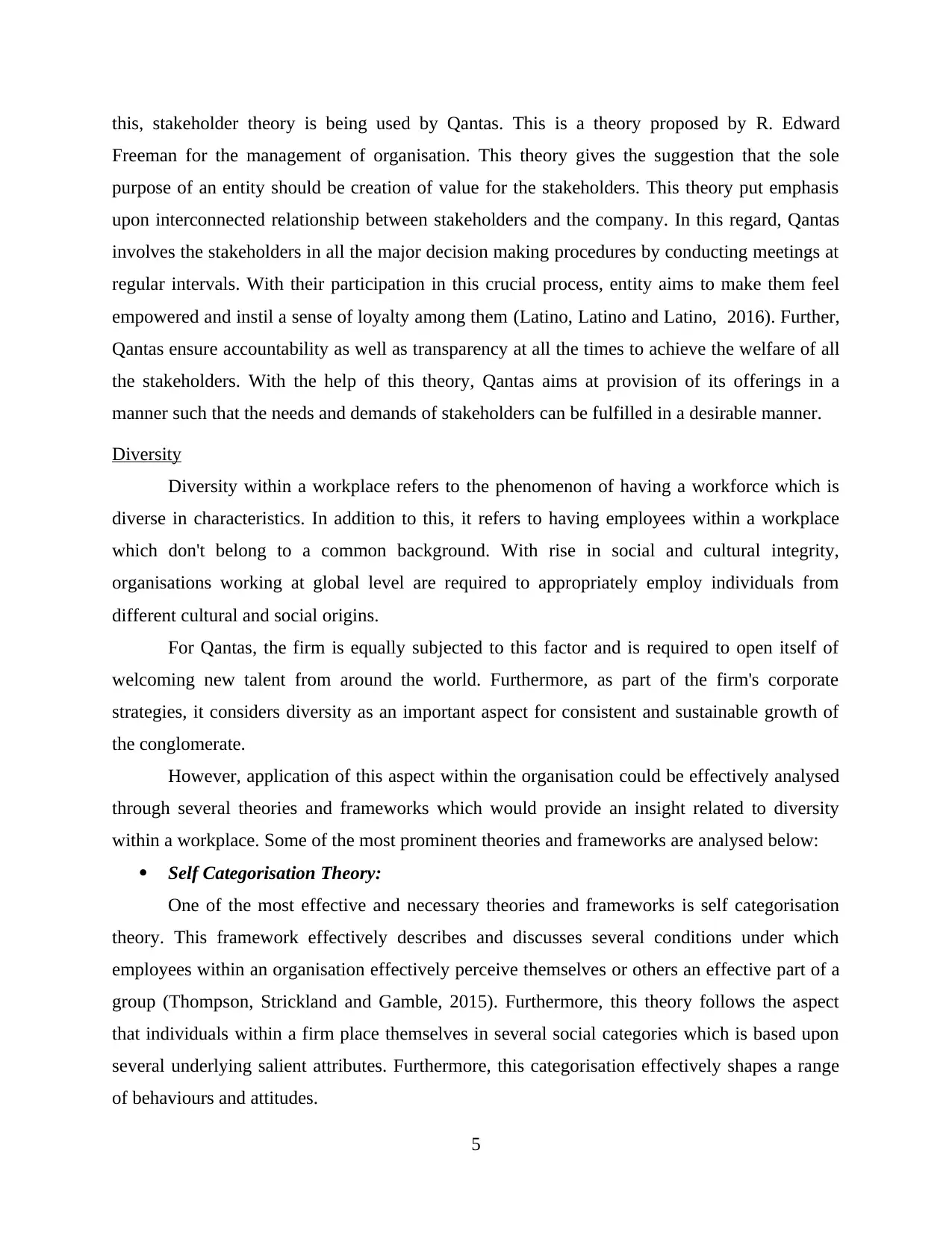
this, stakeholder theory is being used by Qantas. This is a theory proposed by R. Edward
Freeman for the management of organisation. This theory gives the suggestion that the sole
purpose of an entity should be creation of value for the stakeholders. This theory put emphasis
upon interconnected relationship between stakeholders and the company. In this regard, Qantas
involves the stakeholders in all the major decision making procedures by conducting meetings at
regular intervals. With their participation in this crucial process, entity aims to make them feel
empowered and instil a sense of loyalty among them (Latino, Latino and Latino, 2016). Further,
Qantas ensure accountability as well as transparency at all the times to achieve the welfare of all
the stakeholders. With the help of this theory, Qantas aims at provision of its offerings in a
manner such that the needs and demands of stakeholders can be fulfilled in a desirable manner.
Diversity
Diversity within a workplace refers to the phenomenon of having a workforce which is
diverse in characteristics. In addition to this, it refers to having employees within a workplace
which don't belong to a common background. With rise in social and cultural integrity,
organisations working at global level are required to appropriately employ individuals from
different cultural and social origins.
For Qantas, the firm is equally subjected to this factor and is required to open itself of
welcoming new talent from around the world. Furthermore, as part of the firm's corporate
strategies, it considers diversity as an important aspect for consistent and sustainable growth of
the conglomerate.
However, application of this aspect within the organisation could be effectively analysed
through several theories and frameworks which would provide an insight related to diversity
within a workplace. Some of the most prominent theories and frameworks are analysed below:
Self Categorisation Theory:
One of the most effective and necessary theories and frameworks is self categorisation
theory. This framework effectively describes and discusses several conditions under which
employees within an organisation effectively perceive themselves or others an effective part of a
group (Thompson, Strickland and Gamble, 2015). Furthermore, this theory follows the aspect
that individuals within a firm place themselves in several social categories which is based upon
several underlying salient attributes. Furthermore, this categorisation effectively shapes a range
of behaviours and attitudes.
5
Freeman for the management of organisation. This theory gives the suggestion that the sole
purpose of an entity should be creation of value for the stakeholders. This theory put emphasis
upon interconnected relationship between stakeholders and the company. In this regard, Qantas
involves the stakeholders in all the major decision making procedures by conducting meetings at
regular intervals. With their participation in this crucial process, entity aims to make them feel
empowered and instil a sense of loyalty among them (Latino, Latino and Latino, 2016). Further,
Qantas ensure accountability as well as transparency at all the times to achieve the welfare of all
the stakeholders. With the help of this theory, Qantas aims at provision of its offerings in a
manner such that the needs and demands of stakeholders can be fulfilled in a desirable manner.
Diversity
Diversity within a workplace refers to the phenomenon of having a workforce which is
diverse in characteristics. In addition to this, it refers to having employees within a workplace
which don't belong to a common background. With rise in social and cultural integrity,
organisations working at global level are required to appropriately employ individuals from
different cultural and social origins.
For Qantas, the firm is equally subjected to this factor and is required to open itself of
welcoming new talent from around the world. Furthermore, as part of the firm's corporate
strategies, it considers diversity as an important aspect for consistent and sustainable growth of
the conglomerate.
However, application of this aspect within the organisation could be effectively analysed
through several theories and frameworks which would provide an insight related to diversity
within a workplace. Some of the most prominent theories and frameworks are analysed below:
Self Categorisation Theory:
One of the most effective and necessary theories and frameworks is self categorisation
theory. This framework effectively describes and discusses several conditions under which
employees within an organisation effectively perceive themselves or others an effective part of a
group (Thompson, Strickland and Gamble, 2015). Furthermore, this theory follows the aspect
that individuals within a firm place themselves in several social categories which is based upon
several underlying salient attributes. Furthermore, this categorisation effectively shapes a range
of behaviours and attitudes.
5
Paraphrase This Document
Need a fresh take? Get an instant paraphrase of this document with our AI Paraphraser
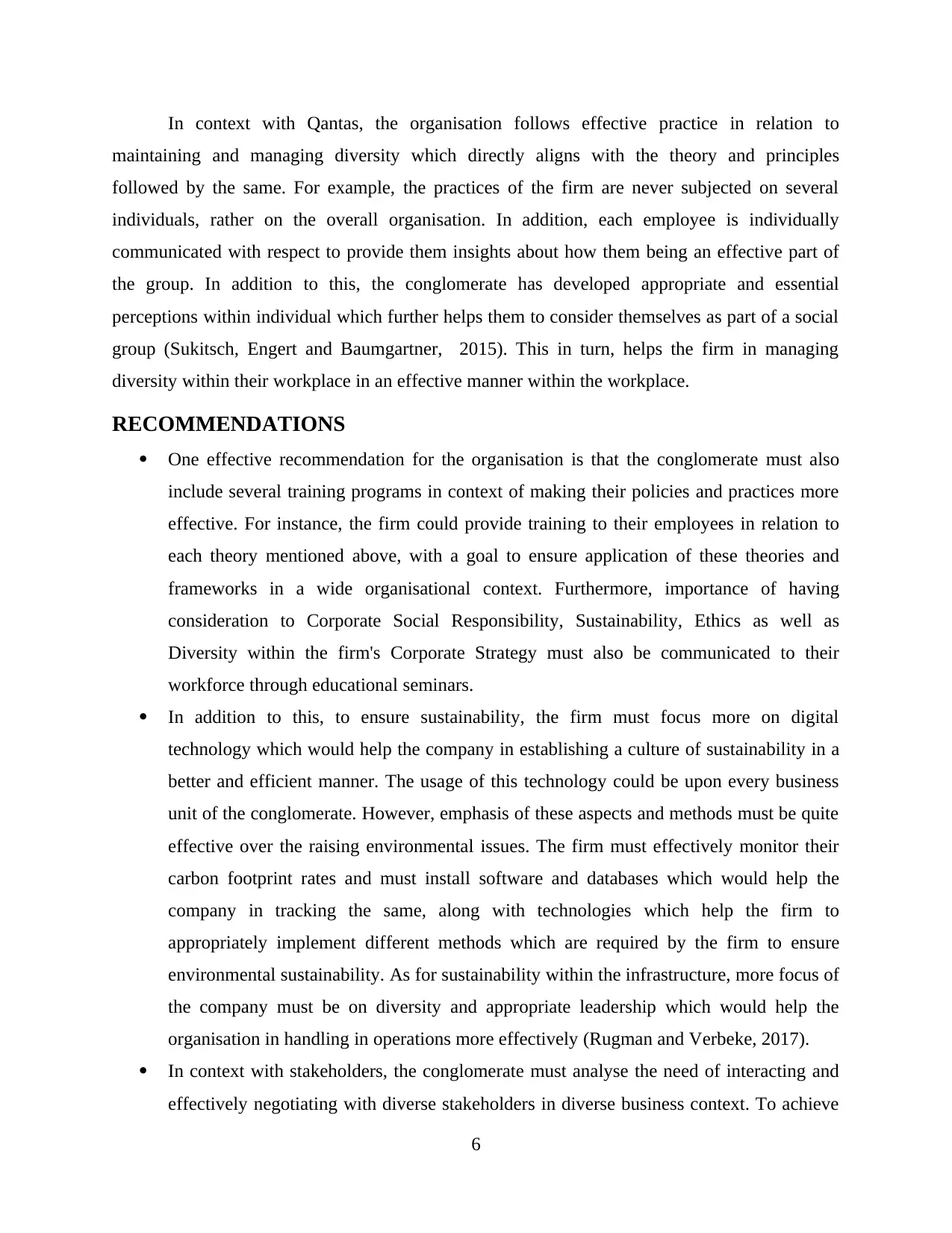
In context with Qantas, the organisation follows effective practice in relation to
maintaining and managing diversity which directly aligns with the theory and principles
followed by the same. For example, the practices of the firm are never subjected on several
individuals, rather on the overall organisation. In addition, each employee is individually
communicated with respect to provide them insights about how them being an effective part of
the group. In addition to this, the conglomerate has developed appropriate and essential
perceptions within individual which further helps them to consider themselves as part of a social
group (Sukitsch, Engert and Baumgartner, 2015). This in turn, helps the firm in managing
diversity within their workplace in an effective manner within the workplace.
RECOMMENDATIONS
One effective recommendation for the organisation is that the conglomerate must also
include several training programs in context of making their policies and practices more
effective. For instance, the firm could provide training to their employees in relation to
each theory mentioned above, with a goal to ensure application of these theories and
frameworks in a wide organisational context. Furthermore, importance of having
consideration to Corporate Social Responsibility, Sustainability, Ethics as well as
Diversity within the firm's Corporate Strategy must also be communicated to their
workforce through educational seminars.
In addition to this, to ensure sustainability, the firm must focus more on digital
technology which would help the company in establishing a culture of sustainability in a
better and efficient manner. The usage of this technology could be upon every business
unit of the conglomerate. However, emphasis of these aspects and methods must be quite
effective over the raising environmental issues. The firm must effectively monitor their
carbon footprint rates and must install software and databases which would help the
company in tracking the same, along with technologies which help the firm to
appropriately implement different methods which are required by the firm to ensure
environmental sustainability. As for sustainability within the infrastructure, more focus of
the company must be on diversity and appropriate leadership which would help the
organisation in handling in operations more effectively (Rugman and Verbeke, 2017).
In context with stakeholders, the conglomerate must analyse the need of interacting and
effectively negotiating with diverse stakeholders in diverse business context. To achieve
6
maintaining and managing diversity which directly aligns with the theory and principles
followed by the same. For example, the practices of the firm are never subjected on several
individuals, rather on the overall organisation. In addition, each employee is individually
communicated with respect to provide them insights about how them being an effective part of
the group. In addition to this, the conglomerate has developed appropriate and essential
perceptions within individual which further helps them to consider themselves as part of a social
group (Sukitsch, Engert and Baumgartner, 2015). This in turn, helps the firm in managing
diversity within their workplace in an effective manner within the workplace.
RECOMMENDATIONS
One effective recommendation for the organisation is that the conglomerate must also
include several training programs in context of making their policies and practices more
effective. For instance, the firm could provide training to their employees in relation to
each theory mentioned above, with a goal to ensure application of these theories and
frameworks in a wide organisational context. Furthermore, importance of having
consideration to Corporate Social Responsibility, Sustainability, Ethics as well as
Diversity within the firm's Corporate Strategy must also be communicated to their
workforce through educational seminars.
In addition to this, to ensure sustainability, the firm must focus more on digital
technology which would help the company in establishing a culture of sustainability in a
better and efficient manner. The usage of this technology could be upon every business
unit of the conglomerate. However, emphasis of these aspects and methods must be quite
effective over the raising environmental issues. The firm must effectively monitor their
carbon footprint rates and must install software and databases which would help the
company in tracking the same, along with technologies which help the firm to
appropriately implement different methods which are required by the firm to ensure
environmental sustainability. As for sustainability within the infrastructure, more focus of
the company must be on diversity and appropriate leadership which would help the
organisation in handling in operations more effectively (Rugman and Verbeke, 2017).
In context with stakeholders, the conglomerate must analyse the need of interacting and
effectively negotiating with diverse stakeholders in diverse business context. To achieve
6
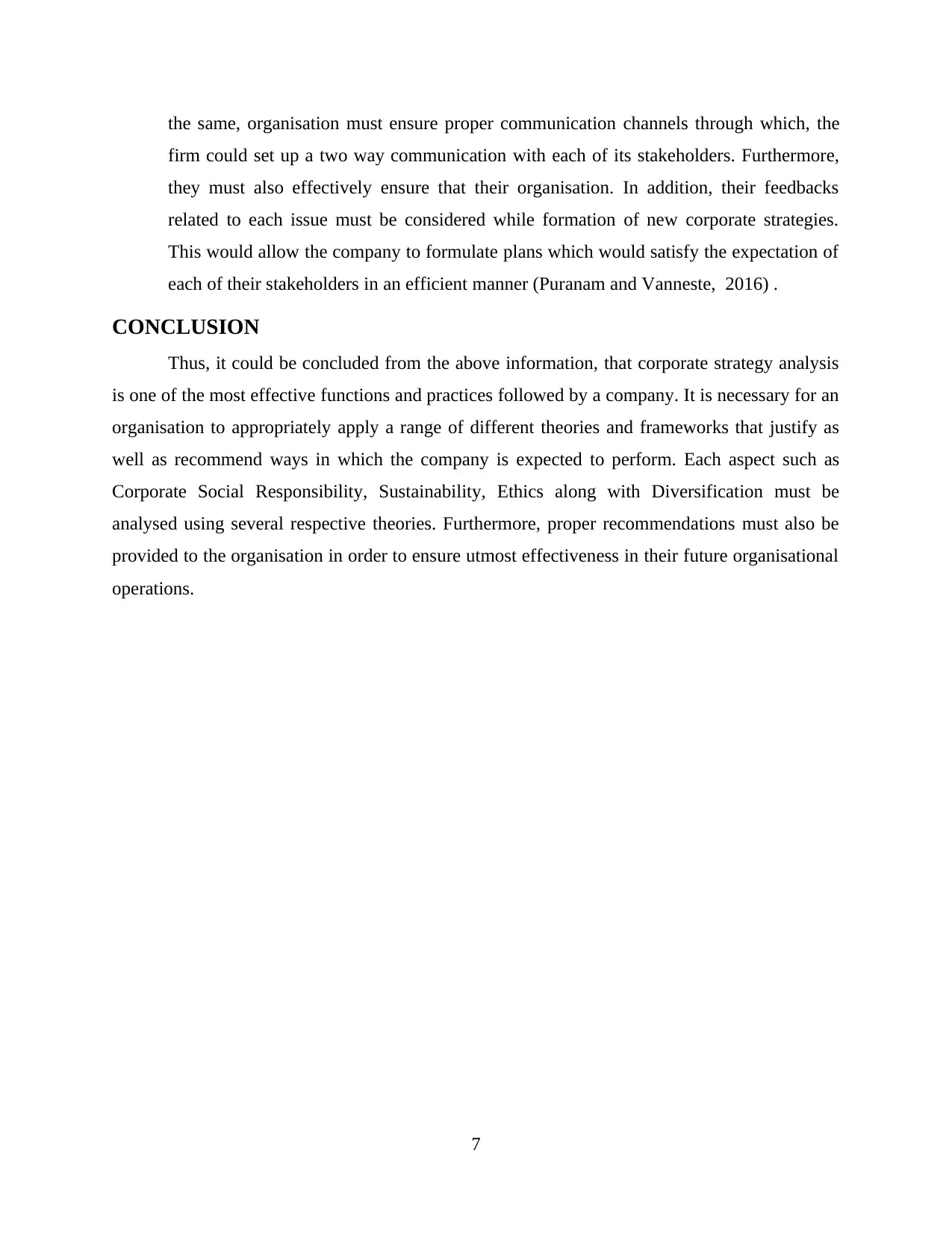
the same, organisation must ensure proper communication channels through which, the
firm could set up a two way communication with each of its stakeholders. Furthermore,
they must also effectively ensure that their organisation. In addition, their feedbacks
related to each issue must be considered while formation of new corporate strategies.
This would allow the company to formulate plans which would satisfy the expectation of
each of their stakeholders in an efficient manner (Puranam and Vanneste, 2016) .
CONCLUSION
Thus, it could be concluded from the above information, that corporate strategy analysis
is one of the most effective functions and practices followed by a company. It is necessary for an
organisation to appropriately apply a range of different theories and frameworks that justify as
well as recommend ways in which the company is expected to perform. Each aspect such as
Corporate Social Responsibility, Sustainability, Ethics along with Diversification must be
analysed using several respective theories. Furthermore, proper recommendations must also be
provided to the organisation in order to ensure utmost effectiveness in their future organisational
operations.
7
firm could set up a two way communication with each of its stakeholders. Furthermore,
they must also effectively ensure that their organisation. In addition, their feedbacks
related to each issue must be considered while formation of new corporate strategies.
This would allow the company to formulate plans which would satisfy the expectation of
each of their stakeholders in an efficient manner (Puranam and Vanneste, 2016) .
CONCLUSION
Thus, it could be concluded from the above information, that corporate strategy analysis
is one of the most effective functions and practices followed by a company. It is necessary for an
organisation to appropriately apply a range of different theories and frameworks that justify as
well as recommend ways in which the company is expected to perform. Each aspect such as
Corporate Social Responsibility, Sustainability, Ethics along with Diversification must be
analysed using several respective theories. Furthermore, proper recommendations must also be
provided to the organisation in order to ensure utmost effectiveness in their future organisational
operations.
7
⊘ This is a preview!⊘
Do you want full access?
Subscribe today to unlock all pages.

Trusted by 1+ million students worldwide
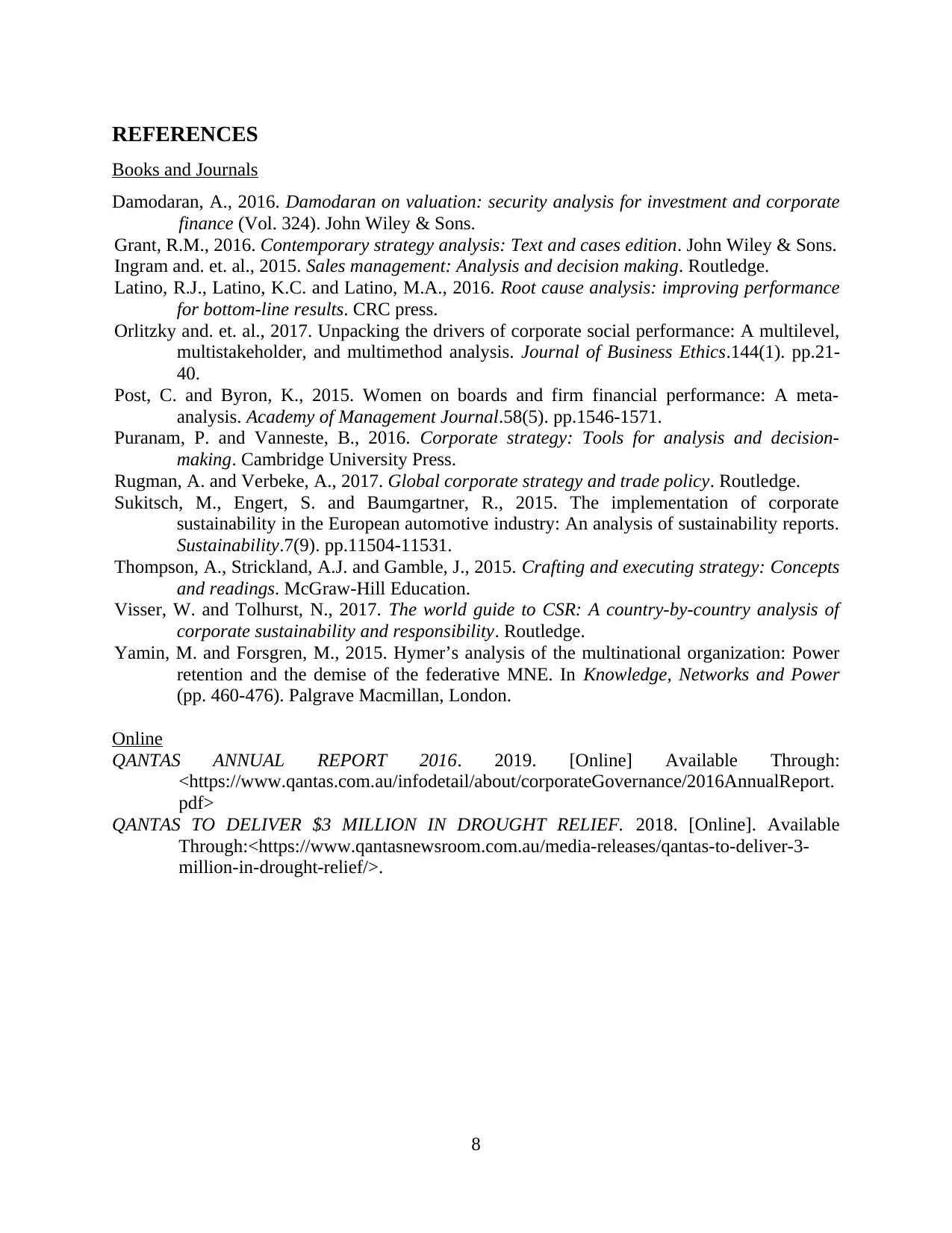
REFERENCES
Books and Journals
Damodaran, A., 2016. Damodaran on valuation: security analysis for investment and corporate
finance (Vol. 324). John Wiley & Sons.
Grant, R.M., 2016. Contemporary strategy analysis: Text and cases edition. John Wiley & Sons.
Ingram and. et. al., 2015. Sales management: Analysis and decision making. Routledge.
Latino, R.J., Latino, K.C. and Latino, M.A., 2016. Root cause analysis: improving performance
for bottom-line results. CRC press.
Orlitzky and. et. al., 2017. Unpacking the drivers of corporate social performance: A multilevel,
multistakeholder, and multimethod analysis. Journal of Business Ethics.144(1). pp.21-
40.
Post, C. and Byron, K., 2015. Women on boards and firm financial performance: A meta-
analysis. Academy of Management Journal.58(5). pp.1546-1571.
Puranam, P. and Vanneste, B., 2016. Corporate strategy: Tools for analysis and decision-
making. Cambridge University Press.
Rugman, A. and Verbeke, A., 2017. Global corporate strategy and trade policy. Routledge.
Sukitsch, M., Engert, S. and Baumgartner, R., 2015. The implementation of corporate
sustainability in the European automotive industry: An analysis of sustainability reports.
Sustainability.7(9). pp.11504-11531.
Thompson, A., Strickland, A.J. and Gamble, J., 2015. Crafting and executing strategy: Concepts
and readings. McGraw-Hill Education.
Visser, W. and Tolhurst, N., 2017. The world guide to CSR: A country-by-country analysis of
corporate sustainability and responsibility. Routledge.
Yamin, M. and Forsgren, M., 2015. Hymer’s analysis of the multinational organization: Power
retention and the demise of the federative MNE. In Knowledge, Networks and Power
(pp. 460-476). Palgrave Macmillan, London.
Online
QANTAS ANNUAL REPORT 2016. 2019. [Online] Available Through:
<https://www.qantas.com.au/infodetail/about/corporateGovernance/2016AnnualReport.
pdf>
QANTAS TO DELIVER $3 MILLION IN DROUGHT RELIEF. 2018. [Online]. Available
Through:<https://www.qantasnewsroom.com.au/media-releases/qantas-to-deliver-3-
million-in-drought-relief/>.
8
Books and Journals
Damodaran, A., 2016. Damodaran on valuation: security analysis for investment and corporate
finance (Vol. 324). John Wiley & Sons.
Grant, R.M., 2016. Contemporary strategy analysis: Text and cases edition. John Wiley & Sons.
Ingram and. et. al., 2015. Sales management: Analysis and decision making. Routledge.
Latino, R.J., Latino, K.C. and Latino, M.A., 2016. Root cause analysis: improving performance
for bottom-line results. CRC press.
Orlitzky and. et. al., 2017. Unpacking the drivers of corporate social performance: A multilevel,
multistakeholder, and multimethod analysis. Journal of Business Ethics.144(1). pp.21-
40.
Post, C. and Byron, K., 2015. Women on boards and firm financial performance: A meta-
analysis. Academy of Management Journal.58(5). pp.1546-1571.
Puranam, P. and Vanneste, B., 2016. Corporate strategy: Tools for analysis and decision-
making. Cambridge University Press.
Rugman, A. and Verbeke, A., 2017. Global corporate strategy and trade policy. Routledge.
Sukitsch, M., Engert, S. and Baumgartner, R., 2015. The implementation of corporate
sustainability in the European automotive industry: An analysis of sustainability reports.
Sustainability.7(9). pp.11504-11531.
Thompson, A., Strickland, A.J. and Gamble, J., 2015. Crafting and executing strategy: Concepts
and readings. McGraw-Hill Education.
Visser, W. and Tolhurst, N., 2017. The world guide to CSR: A country-by-country analysis of
corporate sustainability and responsibility. Routledge.
Yamin, M. and Forsgren, M., 2015. Hymer’s analysis of the multinational organization: Power
retention and the demise of the federative MNE. In Knowledge, Networks and Power
(pp. 460-476). Palgrave Macmillan, London.
Online
QANTAS ANNUAL REPORT 2016. 2019. [Online] Available Through:
<https://www.qantas.com.au/infodetail/about/corporateGovernance/2016AnnualReport.
pdf>
QANTAS TO DELIVER $3 MILLION IN DROUGHT RELIEF. 2018. [Online]. Available
Through:<https://www.qantasnewsroom.com.au/media-releases/qantas-to-deliver-3-
million-in-drought-relief/>.
8
1 out of 10
Related Documents
Your All-in-One AI-Powered Toolkit for Academic Success.
+13062052269
info@desklib.com
Available 24*7 on WhatsApp / Email
![[object Object]](/_next/static/media/star-bottom.7253800d.svg)
Unlock your academic potential
Copyright © 2020–2025 A2Z Services. All Rights Reserved. Developed and managed by ZUCOL.





